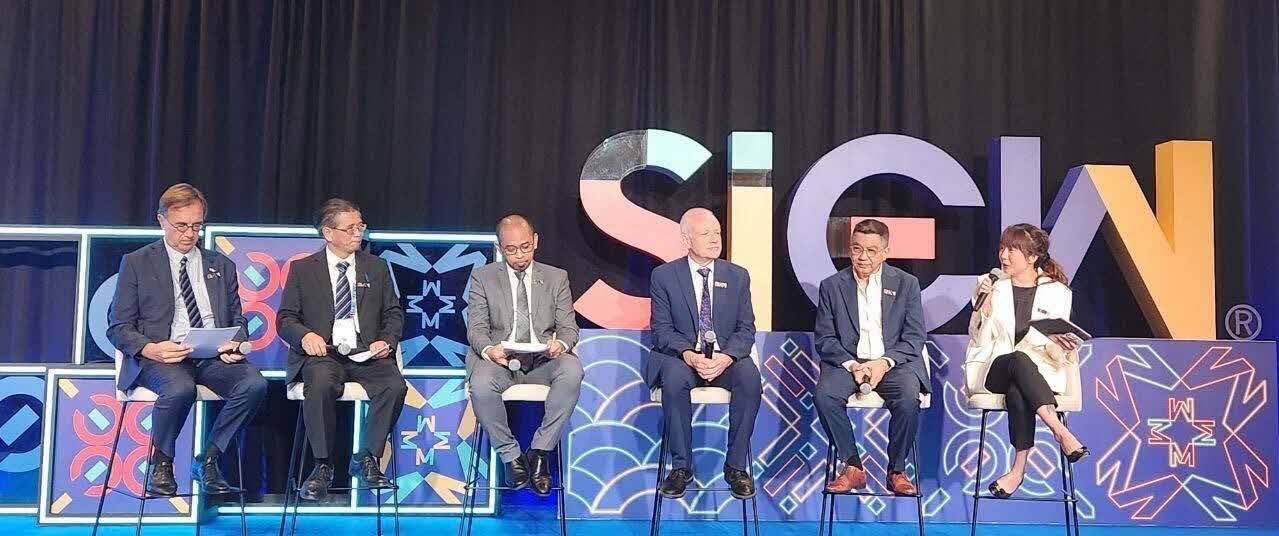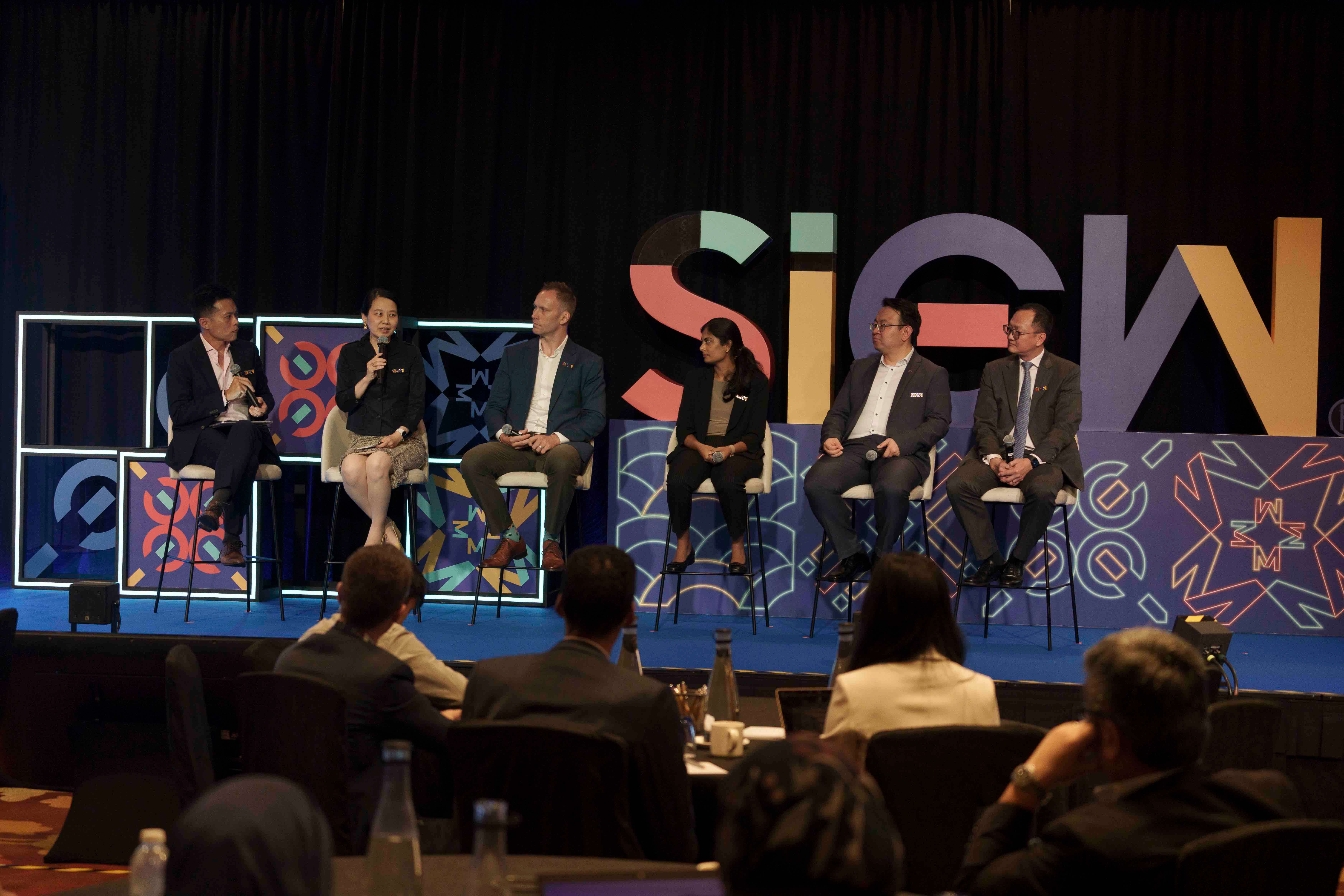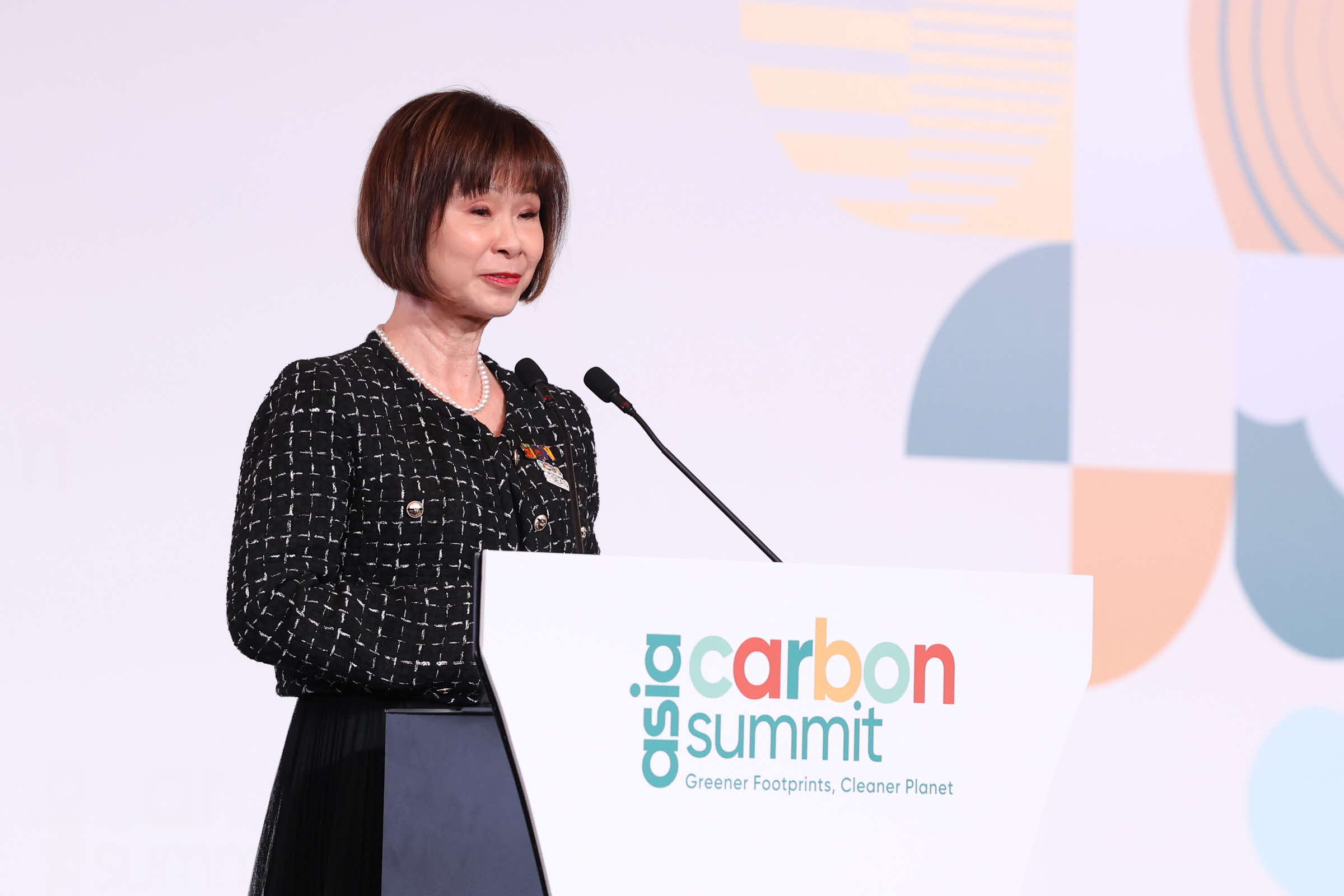Day 4 Wrap-Up: Strategies and Innovations for Low Carbon Energy Pathways
The penultimate day of the Singapore International Energy Week (SIEW) 2024 began with an opening address from Dr Amy Khor, Senior Minister of State, Ministry of Sustainability and the Environment & Ministry of Transport, at the Asia Carbon Summit. Day 4 also saw the launch of SIEW Thinktank Roundtables, exploring topics such as nuclear energy developments and latest trends in sustainable aviation fuels.

The final day of SIEW 2024 will conclude with the third and final roundtable at the SIEW Thinktank Roundtables. Don’t miss all the insights!
What have been your most significant takeaways from SIEW 2024 so far? Let us know by participating in our quick survey.
Follow us on X (formerly Twitter) and Telegram for the latest updates.
Read more
Stay connected with live updates throughout the day. Follow @SIEW_sg on Telegram and Twitter for key takeaways from Day 4's discussions!
SIEW Thinktank Roundtables: Mapping Electric Vehicle Adoption Timelines and Infrastructure Challenges
Industry experts discussed the tipping point for passenger vehicle electrification, battery standardisation, Vehicle-to-Grid implementation, and market structure requirements.

Dr Naoko Doi, Senior Research Director, Assistant Director, Climate Change and Energy Efficiency Unit, The Institute of Energy Economics, Japan (IEEJ), kicked off this SIEW Thinktank Roundtables session by highlighting differences in unit costs. She explained that these costs vary widely in manufacturing powertrains, even within hybrid and pure electric vehicles, due to differences in technical designs and parts involved. This unit cost impacts the tipping point, or the point at which adoption becomes mainstream.
Dr Doi estimated that the tipping point for mainstream passenger electric vehicle adoption would happen between 2025 and 2030. As for heavy vehicles, she said the tipping point would be reached only later in 2035, given the vastly different context, uses, and user expectations for this category of vehicles.
The panel also acknowledged that Vehicle-to-Grid (V2G) implementation was still a long-term work in progress. Yet, according to Dr Dhivya Sampath Kumar, Assistant Professor, Singapore Institute of Technology, technical competence and resources were not the obstacle. Instead, the main challenge was defining the rules and regulations that would frame the incentivisation, consumption, and provisioning of energy through batteries.
Dean Cher, Head, SP Mobility, SP Group, concurred with Dr Kumar’s point by highlighting the practical limits of today’s market structure paradigm. “For instance, if you use my grid and pay 70 cents, and you’re expecting to be paid one dollar for providing your vehicle’s power back to the grid: that’s not going to happen. I think you’d be happy if I gave you 20 cents. Essentially, a new market structure needs to exist for the whole ecosystem to work.”
In terms of battery technology advancements and management, Douglas Duncan, Head of Strategic Development, Durapower Group, highlighted that battery standardisation was still a significant obstacle globally. He cited China as a rare successful example of implementing very standardised fleets of trucks and commercial vehicles. In his view, two-wheeled vehicles are ideal for uniform battery designs and standards.
Alex Bao Zhuangfei, Head of SEA Region, Zeekr, clarified to audiences that it was mandatory for a manufacturer to provide data relating to battery ownership and physical condition of the unit. This is necessary to create more defined and unified battery technology management.
Stay connected with live updates throughout the day. Follow @SIEW_sg on Telegram and Twitter for key takeaways from Day 4's discussions!
SIEW Thinktank Roundtables: SAF and Biofuels in the Future of Sustainable Aviation
As the aviation sector seeks to decarbonise, experts at this SIEW Thinktank Roundtables session explored how Southeast Asia could scale up Sustainable Aviation Fuel (SAF) production and address supply chain and policy challenges.
- Challenges and opportunities for biofuels: Chun Sheng Goh, Programme Officer Bioenergy, International Renewable Energy Agency (IRENA), highlighted the aviation sector's unique decarbonisation challenge, given its reliance on energy-dense fuels. He emphasised the potential of SAF in Southeast Asia but pointed out that meeting its demand solely through residues and waste would be difficult. He suggested turning to unutilised, low-carbon land for energy crops to supplement feedstock. Mr Chun also called for regional collaboration and robust governance to ensure that large-scale biofuel deployment can proceed without negative impacts.
- Addressing supply chain hurdles in production: Andy Loh, Commercial Director Southeast Asia, Advario, highlighted the logistical challenges in SAF production, particularly feedstock transportation. He emphasised the need to make SAF cost-competitive with conventional jet fuel, and praised Singapore's gradual approach to increasing the mandates for SAF as a balanced way to develop the industry.Dr
- SAF key to industrial growth: Reed Blakemore, Director of Research and Programs, Global Energy Center, Atlantic Council, positioned SAF as both an environmentally friendly solution and an industrial opportunity. He emphasised that well-crafted policies could promote scalability while maintaining competitiveness, linking aviation decarbonisation to broader industrial growth.
- Growing demand for SAF across Southeast Asia: Sharmaine Tan, Regional Sustainability Lead, Southeast Asia, Boeing, highlighted the strong demand signals for SAF in the region, pointing out that over 20 airlines have committed to SAF targets. She highlighted the need for harmonised policies across the region, noting that without alignment, market distortions could arise, potentially hindering the industry's progress.
- Financing SAF projects via commercial banks: Roger Charles, Executive Director, Sustainability, Institutional Banking Group, DBS, focused on the role of commercial banks in supporting SAF projects. He stressed the need for bankable projects and called for blended financing models and public-private partnerships to assist smaller, independent SAF producers. Such financial structures would help overcome gaps in funding and facilitate scale-up.Dr
- Public-private collaboration for SAF in emerging markets: Dr Priyank Lathwal, Energy Specialist, World Bank Group, discussed the World Bank's efforts to support SAF production in emerging and developing countries. He emphasised the importance of government intervention and public-private collaboration to close the cost gap that currently makes SAF investments less attractive. According to Dr Lathwal, addressing this gap is crucial to making SAF a viable option in less developed markets.
Stay connected with live updates throughout the day. Follow @SIEW_sg on Telegram and Twitter for key takeaways from Day 4's discussions!
SIEW Thinktank Roundtables: Small Modular Reactors in Asia’s Low Carbon Energy Future
At this SIEW Thinktank Roundtables session, experts shared how nuclear innovations like Small Modular Reactors (SMRs) could help Asia reach its net zero ambitions and reshape the region's energy landscape.
.jpg?sfvrsn=4f59ef79_1)
- Advancements in nuclear technologies: The transition to safer and more efficient Generation 4 nuclear technologies, including SMRs, offers modular and scalable solutions that could accelerate nuclear deployment. Dr Victor Nian, Founding Co-Chair, Centre for Strategic Energy and Resources, emphasised the importance of these innovations for nuclear energy in Southeast Asia.
- De-risking nuclear adoption with advanced safety measures: Modern nuclear reactors feature advanced safety measures, such as passive cooling systems and alternative coolants, which significantly reduce risks. Dr Michael Philip Short, Adjunct Professor, Institute of Materials Research and Engineering (IMRE), Agency for Science, Technology, and Research (A*STAR), highlighted how these innovations make nuclear energy a reliable complement to renewables in achieving net zero targets.
- Powering off-grid communities using nuclear energy: Several countries, including South Korea, are ramping up nuclear power to meet carbon neutrality targets by 2050. Jin Young Lee, Senior Researcher, HYUNDAI Engineering & Construction, discussed the potential of using nuclear energy technologies, especially SMRs, to provide power for remote, off-grid communities.
- Providing critical support for nuclear development: Government incentives, regulatory support, and demonstration projects are crucial to advancing nuclear energy adoption. Thomas Lui, Associate Director for Decarbonisation Architecture, CLP Power Hong Kong Limited, stressed the need for streamlined approvals and public-private collaborations to scale up new nuclear technologies.
- The importance of international collaboration and regulatory frameworks: Cross-border partnerships and "123 agreements" are vital for building regulatory capacity and sharing expertise. Celeste Marshall, International Relations Specialist, Office of Asian Affairs, United States Department of Energy, explained how these frameworks help facilitate safe and effective nuclear energy expansion in Southeast Asia.
Stay connected with live updates throughout the day. Follow @SIEW_sg on Telegram and Twitter for key takeaways from Day 4's discussions!
SIEW Thinktank Roundtables: Building Trust in Nuclear Energy through Public Engagement and Regional Cooperation
The panel explored how public engagement, transparent communication, and regional collaboration are essential for building trust in nuclear energy as part of the global energy transition. Audrey Tan, Assistant News Editor, The Straits Times, moderated the lively panel discussion.
.jpg?sfvrsn=ae59ef79_1)
- France’s approach to addressing nuclear safety concerns: Dr Jean-Christophe Niel, Director General, Institute for Radiation Protection and Nuclear Safety, emphasised the importance of transparency and public participation in nuclear projects. Using France as an example, Dr Niel explained how the country’s Local Commission for Information would actively involve stakeholders when addressing safety concerns. This approach not only improves safety education but also fosters trust and understanding among members of the public, a crucial factor in the success of nuclear initiatives.
- Indonesia’s approach to dispelling misconceptions about nuclear energy: Indonesia plans to add nuclear power to its energy mix, targeting commercial operations by 2032. Bob Soelaiman Effendi, Chief Operating Officer, PT Thorcon Power Indonesia, emphasised that public acceptance would depend on providing factual, science-based information to address misconceptions about nuclear development
- Promoting nuclear energy’s advantages to gain public buy-in: Dr Jonathan Cobb, Senior Programme Lead, Climate, the World Nuclear Association, pointed out that an overemphasis on safety can inadvertently create suspicion. Instead, he recommended promoting nuclear energy’s advantages, such as its ability to provide a clean, reliable electricity supply, as a more effective strategy for building public support.
- Regional cooperation plays a vital role in advancing nuclear energy: Beni Suryadi, Acting Executive Director, ASEAN Centre for Energy, underscored the importance of ASEAN countries working together on nuclear safety, security, and waste management. With each country starting from different points, collaboration across the region is essential to ensure safe and sustainable nuclear development that meets the varying needs of individual nations.
- Building trust through citizen science projects: In Singapore, public education and outreach are at the heart of nuclear energy efforts. Dr Chung Keng Yeow, Director, Singapore Nuclear Research and Safety Initiative, emphasised the need to address misconceptions about nuclear energy through clear, transparent communication. He also advocated for engaging the public in citizen science projects to help build trust and confidence in the safety and benefits of nuclear energy.
- Going beyond technological advances: The future of nuclear energy depends not just on technological advancements but on winning public trust, fostering regional cooperation, and promoting clear, transparent dialogue about its role in the clean energy transition.
Stay connected with live updates throughout the day. Follow @SIEW_sg on Telegram and Twitter for key takeaways from Day 4's discussions!
SIEW Thinktank Roundtables Examines Nuclear Energy in Singapore’s Future
Jaime Ho, Editor, The Straits Times, framed key considerations for nuclear energy adoption, from current energy mix constraints to the potential of Small Modular Reactors (SMRs) in Singapore.
.jpg?sfvrsn=6859ef79_1)
- Key considerations for nuclear energy adoption: Mr Ho opened the SIEW Thinktank Roundtables by setting the context for Singapore to consider. As a source for future energy needs, nuclear remains an open-ended question. Singapore must weigh its options very carefully as it is still constrained by limited natural resources and an ongoing commitment to sustainability.
- Nuclear as part of Singapore’s energy mix: Mr Ho framed the discussions by questioning Singapore's reliance on its current energy mix of natural gas, imported electricity, and solar power, and exploring whether nuclear power offered a viable alternative. He examined whether nuclear energy was necessary despite expanding renewable capacity. He also discussed how new technologies like SMRs could enhance nuclear's feasibility, and what this could mean for Singapore's energy security and environmental future.
Stay connected with live updates throughout the day. Follow @SIEW_sg on Telegram and Twitter for key takeaways from Day 4's discussions!
Fusion Energy: A Zero Carbon Future for Singapore
Kieran Furlong, CEO, Realta Fusion, explored fusion energy's potential to transform Singapore’s energy landscape, offering a secure and abundant power source for the country’s future.
.jpg?sfvrsn=a59ef79_1)
- The case for fusion as a clean energy source: "Fusion is fundamentally different from fission. Instead of splitting heavy atoms, fusion involves combining light atoms, which converts a tiny amount of mass into a massive amount of energy," Mr Furlong explained. He emphasised that fusion is a zero carbon energy source that uses minuscule quantities of widely available fuel and produces no long-term radioactive waste.
- Public perception is a barrier to fusion energy adoption: Mr Furlong highlighted fusion energy’s potential to transform Singapore’s energy landscape with its promise of an abundant, zero-carbon power source. “The challenge isn’t technical; it’s social acceptance. Despite its proven safety and reliability, nuclear energy struggles with public perception.”
- Singapore’s ideal position for commercialised fusion: As an advanced, industrialised, energy-intensive economy, Singapore is uniquely positioned to harness fusion energy. “Singapore is home to one of the world’s largest petrochemical complexes on Jurong Island, and its long-term freshwater supply strategy depends heavily on energy-intensive desalination,” said Mr Furlong. Fusion could meet the energy demands of these industries and optimise the efficiency of energy-intensive facilities, such as data centres.
- Singapore as a potential leader in fusion: Beyond its energy needs, Singapore has the industrial capabilities to lead in the fusion sector. The country’s expertise in material science, power electronics, and precision manufacturing positions it well to be part of the fusion energy supply chain, making it an
attractive location for overseas fusion companies to establish a presence.
Stay connected with live updates throughout the day. Follow @SIEW_sg on Telegram and Twitter for key takeaways from Day 4's discussions!
Asia Carbon Summit Maps Future of Regional Carbon Trading
Dr Amy Khor, Senior Minister of State, Ministry of Sustainability and the Environment & Ministry of Transport, outlined three key ingredients for carbon market success as Asia seeks to balance economic growth with climate action through innovative financing and cross-border collaboration.

- Asia’s vulnerability to climate change: Dr Khor highlighted that Asia, which is warming at a faster rate than the global average, is especially vulnerable to various weather and climate hazards impacting everyday lives. As such, when it comes to climate change, the stakes are especially high in the region.
- Carbon markets as an enabler of energy transition: Asia has tremendous potential to drive the transition to clean energy. The challenge is in how to achieve decarbonisation goals in a way that enables countries to meet their growing economic and population needs. Carbon markets enable stakeholders to collaborate and explore decarbonisation opportunities that make the most economic sense, given a country’s specific needs and economic circumstances.
- Ingredients for a successful carbon market: Dr Khor identified three key ingredients for an effective carbon market - infrastructure developments that optimise energy value chains; innovative financing models and project types to unlock more carbon mitigation potential; and international cooperation to facilitate cross-border carbon trading and new models of high-quality carbon credits.
Stay connected with live updates throughout the day. Follow @SIEW_sg on Telegram and Twitter for key takeaways from Day 4's discussions!
SIEW 2024 Day 4: Carbon Markets, Nuclear Energy, and Greener Transport
Day 4 at the Singapore International Energy Week (SIEW) 2024 focuses on key challenges shaping Asia's energy future—from carbon markets to sustainable transport.
Get ready to deep dive into conversations that will shape the future energy landscape. Roundtable A will explore the role of nuclear energy in meeting Asian’s need for clean and realiable energy. Meanwhile Roundtable B will discuss the future of transportation covering developments in electric vehicles, sustainable aviation fuels, and collaborative strategies for greener mobility in Asia.
Today will also see Dr Amy Khor, Senior Minister of State, Ministry of Sustainability and the Environment, & Ministry of Transport, deliver opening remarks at the Asia Carbon Summit, This Summit is a milestone for industries navigating Asia's carbon markets.
Stay connected with live updates throughout the day. Follow @SIEW_sg on Telegram and Twitter for key takeaways from Day 4's discussions!